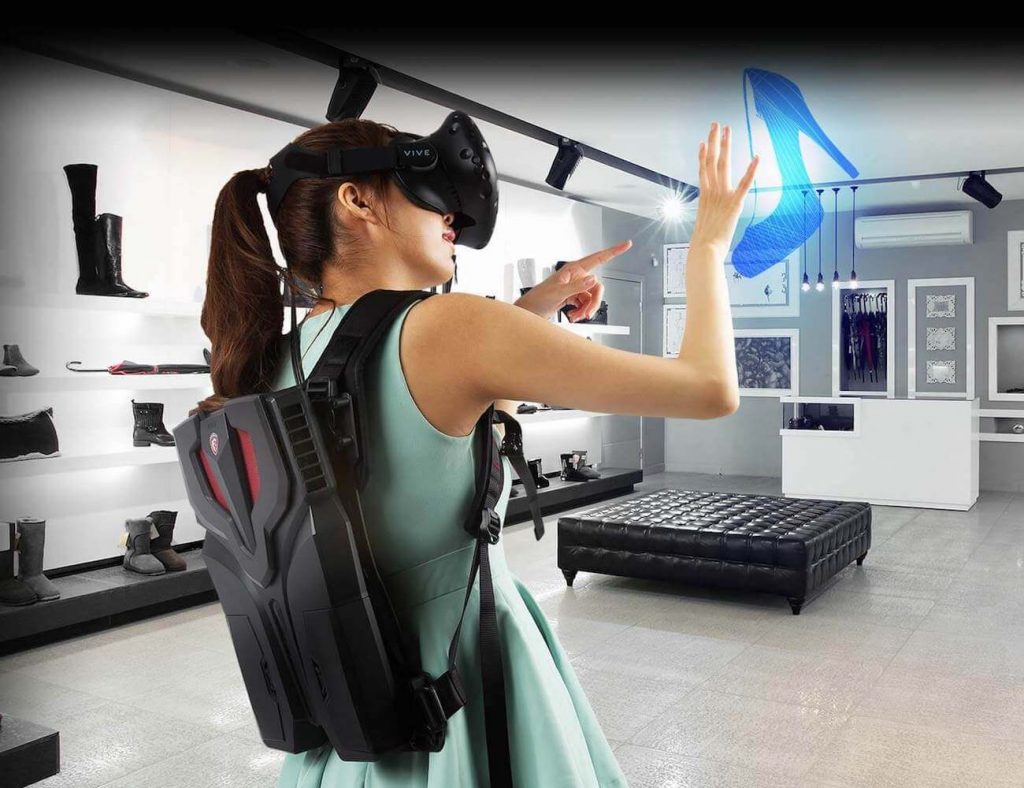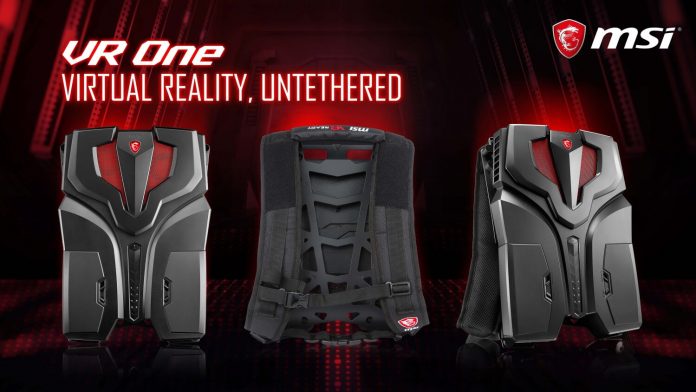The MSI VR One backpack PC surprises with its ability to create greater immersion in virtual reality, to a level that is simply impossible to achieve with a standard computer. The device fits onto your back and is very light in weight. This MSI VR backpack is also very powerful and can effortlessly run virtual reality games in the maximum possible detail. It comes with a miniature cable that can fit the HTC Vive.
While some might think that wearing a PC on one’s back might restrict one’s mobility, in reality, the light weight of the MSI VR One backpack PC, combined with the fact that you are no longer tethered to a static desktop PC (or laptop) via lengths of wires, combine to give one an exhilarating sense of space and freedom.
The infamous wires of the HTC Vive
It has always been a recurring problem with the HTC Vive that its trailing wires tend to destroy immersion. This is because they keep tending to get snagged in one’s legs or wrapped round one’s body. The MSI VR One backpack PC – and other backpack PCs like it – are a solution to this problem that places the PC itself on a user’s back, thus, allowing for complete mobility, and thus, for massive immersion in virtual reality.
The usual constraints created by the fact that one is tethered by a cord that stretches between one’s virtual reality headset and a PC no longer exist, and one can move around freely.
Specifications and configuration of the MSI VR One backpack PC
There are several configurations available that allow you to choose between a high-end or lower-end model. The high-end model will usually incorporate an Intel Core i7-7820HK processor, and an NVIDIA GeForce GTX 1070 graphics card with 16 GB of RAM and a 512 GB SSD.
The performance delivered by the MSI VR backpack is flawless
Its Core i7 processor and the NVIDIA 1070 graphics card handle the latest games quite effortlessly. With later additions of this backpack using 7th generation Core i7s, these are some of the best VR PCs on the market.
The SSD storage ensures that you need not worry about moving parts in your storage device being damaged in virtual reality. However, the SSD does not offer the same storage capacity as a PC’s hard disk provides.
Check out the best deals on MSI VR One
How long do the batteries last?
The MSI VR One backpack PC is powered by two removable batteries. It can stay powered up anytime between 60 to 90 minutes. MSI also sells an extra pair of batteries with their own charger, ensuring that you can have continuous gaming time by simply hot-swapping the batteries. The charging station allows you to charge one set of batteries while the other is in use.
The carrying case
The carrying case of this VR backpack is surprisingly light. It is flat, and attached to a sort of rucksack that has shoulder straps and a belt around the waist. The entire backpack PC weighs around 3.6 kg, which is less weight than one would have expected, and lighter than some of the other backpack PCs on the market today.

Getting started with the MSI VR One backpack PC
All one needs to do to use am MSI VR backpack is to turn it on, slip it on one’s back, and connect it directly to the HTC Vive headset. The connector on the top of the case includes USB ports, HDMI ports, and a power supply for the Vive. Since the HTC Vive comes with extremely long cables that would trail when you wear the backpack, the MSI VR One comes with USB and HDMI cables that are considerably shorter than the official ones and which completely remove the problem of trailing cables. No external adaptor is needed.
Oddly enough, this innovation by MSI has not been incorporated by many other manufacturers of VR backpacks, many of which have a problem with the long cables of the Vive headset still trailing behind the person wearing the backpacks.
Practical details
It might help to have somebody around who would be willing to help with minor adjustments when you are using this backpack PC in virtual reality. Having someone to help out in this way prevents you having to take off the headset and the backpack to make those adjustments, which could be rather a tedious process.
Actually, the short cables provided by MSI for the Vive can be a trifle inconvenient, because it becomes difficult to hold the headset in front of you, to put on the backpack, and then place the headset on one’s head. Once the Vive headset is on your head you still need to put on the headphones and plug them into the Vive socket, which is actually badly placed for this purpose. After all this is done, you still have to get your hands on the controllers.
All-in-all, it’s rather like launching your personal starship – until you actually boot up into virtual reality, that is, when the sense of space and freedom about you is nothing short of exceptional. In any case, having a friend around to help you with these tiny details can be a big help.
Click here for the best MSI VR One prices
Complete freedom in virtual reality
Once the backpack and the headset are working together, everything becomes effortless. You lose the feeling of being artificially put into virtual reality, and with all your movements being perfectly natural and being tracked in virtual reality, this backpack and headset system provides the greatest possible immersion that is possible to achieve in virtual reality.
The lack of Vive cables proves astonishingly liberating. Even experienced users of VR will never have attained the freedom of movement that this MSI VR backpack offers.
The VR One is especially suited to games where you are exploring an interesting virtual reality environment, such as in Forgotten Realms, for example. Rec Room is another game that works very well in virtual reality.
It goes without saying that paintball games are exponentially better when you need not trouble your head over entangling cables. In a game like Space Pirate Trainer, we no longer had to move carefully so as not to snag the cables, but instead, could completely concentrate upon the game itself.
Can be used as a desktop PC
For the times when you are not in virtual reality, you can also use this backpack PC as a desktop computer, connecting it to a screen via a mini-display port.
A possible downside to this product is that, unlike with a desktop PC, upgrading it might be difficult. Also, while the backpack PC does do its job, its price range might be a little beyond that of the average gamer.
Remember though, that while the MSI VR One might seem expensive, it is actually not much more expensive than most PCs dedicated to virtual reality.
It is also exponentially better suited to experiencing virtual reality than any desktop PC on the market today.
